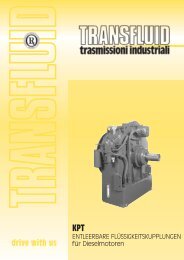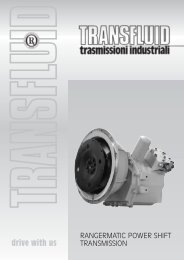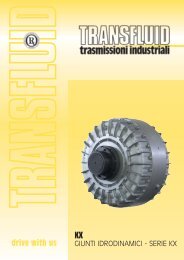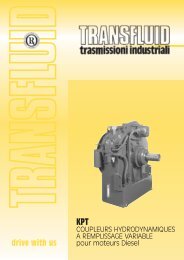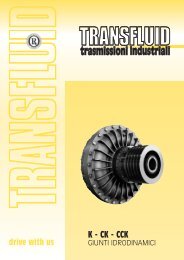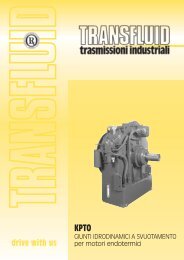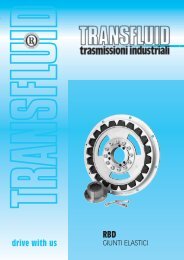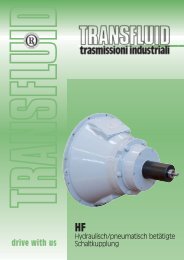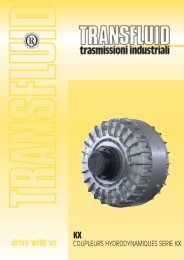K - CK - CCK - Transfluid
K - CK - CCK - Transfluid
K - CK - CCK - Transfluid
You also want an ePaper? Increase the reach of your titles
YUMPU automatically turns print PDFs into web optimized ePapers that Google loves.
DELAYED FILL CHAMBER<br />
ADVANTAGES<br />
2.2 TRANSFLUID FLUID COUPLINGS WITH A DELAYED FILL<br />
CHAMBER<br />
A low starting torque is achieved, with the standard circuit in a<br />
maximum oil fill condition because fluid couplings limit to less<br />
than 200% of the nominal motor torque. It is possible to limit<br />
further the starting torque down to 160% of the nominal torque,<br />
by decreasing oil fill: this, contrarily creates slip and working<br />
temperature increase in the fluid coupling.<br />
The most convenient technical solution is to use fluid couplings<br />
with a delayed fill chamber, connected to the main circuit by<br />
calibrated bleed orifices. These externally adjustable valves,<br />
available from size 15<strong>CK</strong> (Fig. 4b), can be simply adjusted to<br />
vary starting time.<br />
In a standstill position, the delayed fill chamber contains part of<br />
the filling oil, thus reducing the effective quantity in the working<br />
circuit (Fig. 4a) and a torque reduction is obtained, allowing the<br />
motor to quickly reach the steady running speed as if started<br />
without load.<br />
During start-up, oil flows from the delayed fill chamber to the<br />
main circuit (Fig. 4b) in a quantity proportional to the rotating<br />
speed.<br />
As soon as the fluid coupling reaches the nominal speed, all oil<br />
flows into the main circuit (Fig. 4c) and torque is transmitted with<br />
a minimum slip.<br />
With a simple delayed fill chamber, the ratio between starting<br />
and nominal torque may reach 150 %. This ratio may be further<br />
reduced down to 120 % with a double delayed fill chamber,<br />
which contains a higher oil quantity, to be progressively<br />
transferred into the main circuit during the starting phase.<br />
This is ideal for very smooth start-ups with low torque absorptions,<br />
as typically required for machinery with large inertia values and<br />
for belt conveyors.<br />
The advantages of the delayed fill chamber become more and<br />
more evident when the power to be transmitted increases.<br />
The simple chamber is available from size 11<strong>CK</strong>, while the<br />
double chamber from size 15C<strong>CK</strong>.<br />
3. SUMMARY OF THE ADVANTAGES GIVEN BY FLUID<br />
COUPLINGS<br />
– very smooth start-ups<br />
– reduction of current absorptions during the starting phase: the<br />
motor starts with very low load<br />
– protection of the motor and the driven machine from jams and<br />
overloads<br />
– utilization of asynchronous squirrel cage motors instead of<br />
special motors with soft starter devices<br />
– higher duration and operating convenience of the whole drive<br />
train, thanks to the protection function achieved by the fluid<br />
coupling<br />
– higher energy saving, thanks to current peak reduction<br />
– limited starting torque down to 120% in the versions with a<br />
double delayed fill chamber<br />
– same torque at input and output: the motor can supply the<br />
maximum torque even when load is jammed<br />
– torsional vibration absorption for internal combustion engines,<br />
thanks to the presence of a fluid as a power transmission<br />
element<br />
– possibility to achieve a high number of start-ups, also with an<br />
inversion of the rotation direction<br />
– load balancing in case of a double motor drive: fluid couplings<br />
automatically adjust load speed to the motors speed<br />
– high efficiency<br />
– minimum maintenance<br />
– Viton rotating seals<br />
– cast iron and steel material with anticorrosion treatment<br />
valve<br />
Fig. 4 a<br />
AT REST<br />
Fig. 4 b<br />
ACCELERATION<br />
Fig. 4 c<br />
RUNNING<br />
calibrated plug<br />
Oil in reserve for<br />
use after start<br />
Oil available<br />
for initial start<br />
Oil drains from chamber<br />
into main circuit<br />
All oil in circuit<br />
Pag.4<br />
Fluid couplings - 0808<br />
4



